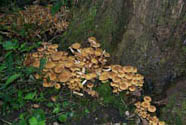 Key to Gilled Mushrooms Key
Key to Gilled Mushrooms KeyThis is a key to gilled mushrooms, that is, mushrooms having a definite cap with a fertile surface consisting of gills. The fruiting body usually also has a stem, although that may be lateral or absent (usually, then, the mushroom is growing from wood). You can use this key to identify mushrooms that you find.
 Agaricales Order
Agaricales OrderFruiting body containing fibers (usually in the stalk)
 White Spored Suborder
White Spored SuborderSpore print "light-colored": white or buff, sometimes tinged with pink or tan. Greenish and (except for the Russulales) yellow spore prints also go here
Stalk fibrous, not fracturing like a piece of chalk
 Tricholomataceae Family
Tricholomataceae FamilyNone of the special features distinguishing the other white-spored genera:
Gills not free, as in the Lepiotas and Amanitas
Basidia not extra-long, as in the Hygrophoraceae
Spores smooth, except for Lentinellus
 Lignicolous Trich Subfamily
Lignicolous Trich SubfamilyGrowing on trees or dead wood, leaves, or sticks, or organic debris, often in moss
 Normal LignoTrich Tribe
Normal LignoTrich TribeShaped like a “normal mushroom”
Small and fragile to medium-sized, except for one large, grey-capped species
Small Ligno Trich SubtribeFruiting body small: cap up to 1 1/4" across (and most clearly smaller than that)
 Omphalinoids SemiTribe
Omphalinoids SemiTribeMature fruiting body with an omphalos, never bell-shaped or conical. Never even flat except when very young.
Usually more colorful than the other choices
Often growing in or among a lichen
Omphalina Genus Quélet

Diagnosis
Microscropic Characters
Comments
Originally "Omphalia"
Narrow down your identification:
Omphalina ectypoidesCap 1- 2 1/2" across, various shades of yellow to brown, at first with minute dark scales or hairs
Not striate; margin wavy but not scalloped
 Omphalina ericetorum
Omphalina ericetorumCap up to 1 1/2" across, usually less than an inch; brown fading to yellow; in age, cap pleated and margin scalloped by the gills
Growing with a lichen which is so inconspicuous that it may be obscured by the moss that it also often grows with






 Key to Gilled Mushrooms Key
Key to Gilled Mushrooms Key Agaricales Order
Agaricales Order White Spored Suborder
White Spored Suborder Tricholomataceae Family
Tricholomataceae Family Lignicolous Trich Subfamily
Lignicolous Trich Subfamily Normal LignoTrich Tribe
Normal LignoTrich Tribe Omphalinoids SemiTribe
Omphalinoids SemiTribe
 Omphalina ericetorum
Omphalina ericetorum




